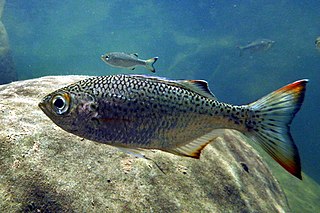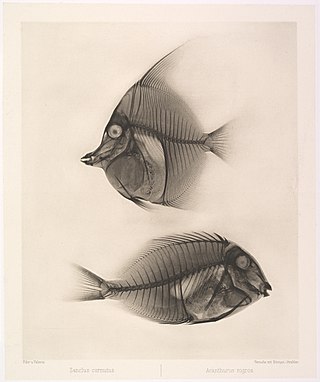
The flagtails are a family (Kuhliidae) of perciform fish of the Indo-Pacific area. The family consists of several species in one genus, Kuhlia. Most are euryhaline and often found in brackish water, but the genus also includes species restricted to marine or fresh water.

Naso vlamingii, the bignose unicornfish, scibbled unicornfish, Vlaming's unicornfish, and zebra unicornfish, is a species of marine ray-finned fish belonging to the family Acanthuridae, the surgeonfishes, unicornfishes and tangs. This species is found in the Indo-Pacific.

Kuhlia marginata, the dark-margined flagtail, spotted flagtail, silver flagtail, orange-finned flagtail, northern jungle perch or mountain bass, is a species of diadromous ray-finned fish, a flagtail from the family Kuhliidae. It is found in eastern Asia and Oceania.

Kalepolepo Fishpond, known by its older name Koʻieʻi.e. Loko Iʻa, is an ancient Hawaiian fishpond estimated to have been built between 1400 and 1500 AD.

The Hawaiian flagtails are species of the genus of flagtail fishes found in the Hawaiian Islands. Two species are Kuhlia sandvicensis and K. xenura. K. xenura is endemic to the islands.

Kuhlia xenura, the strange-tailed flagtail or Hawaii flagtail, is a species of ray-finned fish, a flagtail from the family Kuhliidae which is endemic to Hawaii, where it occurs in fresh, brackish, and marine waters. It can be found in tide pools, estuaries, and on reefs occurring over sand or rock.

Cephalopholis urodeta, the darkfin hind, flagtail rockcod, chevron rockcod, duskyfin hind, duskyfin rockcod, flagtail grouper or V-tail grouper, is a species of marine ray-finned fish, a grouper from the subfamily Epinephelinae which is in the family Serranidae which also includes the anthias and sea basses. This fish occurs in the Western Pacific Ocean and the far eastern Indian Ocean.

Acanthurus nigroris, the bluelined surgeonfish, is a species of marine ray-finned fish belonging to the family Acanthuridae, which includes the surgeonfishes, unicornfishes and tangs. This species and A. nigros have been regarded as synonymous with the combined taxon having a wide Indo-Pacific distribution, if treated as a separate valid species it is confined to the United States Pacific islands.

The imposter trevally, also known as the imposter jack or white-tongued trevally, is a species of small coastal marine fish in the jack family Carangidae. The imposter trevally is distributed through the tropical waters of Indian and west Pacific oceans, from the Gulf of Oman in the west to Japan and Australia in the east. The species is quite similar to the Malabar trevally, but can be distinguished by its gill raker count, and is identifiable from other species by having a white to pale grey tongue. It is a relatively small species, growing to a maximum recorded length of 30 cm. The imposter trevally inhabits coastal waters of the continental shelf in depths of up to 140 m, often associating with closely related carangid species. It preys on a range of small fish, crustaceans and cephalopods, but little is known of its reproductive biology. The imposter trevally is of minor importance to fisheries throughout its range, taken by hook and line, bottom trawls and several types of artisanal gear.

Keāhole Point is the westernmost point of the island of Hawaii. The Kona International Airport was moved here from directly north of the town of Kailua-Kona in 1970, when the previous smaller airstrip was converted into the Old Kona Airport State Recreation Area. The name comes from Ke ʻāhole since the ʻāhole fish was found nearby.

Kuhlia mugil, the barred flagtail, the fiveband flagtail or the five-bar flagtail, is a species of marine ray-finned fish, a flagtail belonging to the family Kuhliidae. It is found in the Indo-Pacific region.
The dara is a species of marine ray-finned fish, a grunt belonging to the family Haemulidae. It is native to the Atlantic coast of Africa. It is the only species in the monospecific genus Parakuhlia.

Parapercis maculata, the harlequin sandperch, is a species of marine bony fish in the family Pinguipedidae, found in shallow waters in the tropical western Indo-Pacific Ocean.

Kuhlia rupestris, the rock flagtail, jungle perch. mountain trout, buffalo bream, dusky-finned bulleye, rockmountain bass or spotted flagtail, is a species of ray-finned fish, a flagtail, from the family Kuhliidae. It is a catadromous species which is native to the Indo-Pacific and northern Australia.
Kuhlia malo is a freshwater and brackish water species of ray-finned fish from the family Kuhliidae which is endemic to French Polynesia.

Kyphosus elegans, the Chopa Mojonera or Cortez chub, is a species of marine ray-finned fish, a sea chub from the family Kyphosidae. It is found in the eastern Pacific Ocean where it is of minor importance to commercial fisheries.

The grey-head surgeonfish is a species of marine ray-finned fish belonging to the family Acanthuridae which includes the surgeonfishes. unicornfishes and tangs. This species has a wide Indo-Pacific distribution.

Cirrhitops mascarenensis is a species of marine ray-finned fish, a hawkfish belonging to the family Cirrhitidae. It is found in the southwestern Indian Ocean.

Cirrhitus pinnulatus, the stocky hawkfish, whitespotted hawkfish or marbled hawkfish, is a species of marine ray-finned fish, a hawkfish belonging to the family Cirrhitidae. It is found in the Indo-West Pacific region.















